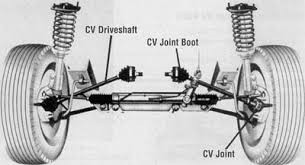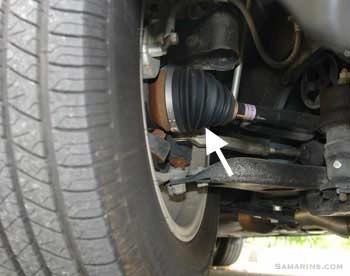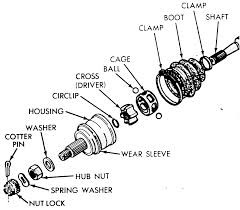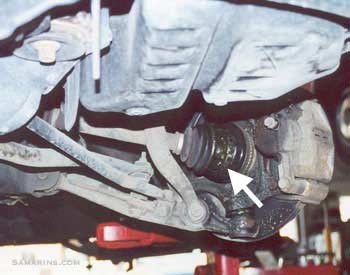Constant Velocity (CV) joints are critical components in modern vehicles, especially those with front-wheel drive, rear-wheel drive, and all-wheel drive systems. These joints are essential for transferring engine torque to the wheels, allowing your car to move smoothly and efficiently, even when steering and navigating uneven road surfaces. Understanding what CV joints are and recognizing potential issues is crucial for vehicle maintenance and ensuring driving safety.
Understanding Car Parts: CV Joints – Function and Location
CV joints, often referred to as constant velocity joints or CV axles, are specialized couplings that sit at the ends of your vehicle’s drive shafts, also known as half shafts. In front-wheel drive cars, you’ll find them on both ends of these drive shafts. The inner CV joints connect the drive shafts to the transmission, which is the source of power from the engine. Conversely, the outer CV joints link the drive shafts to the wheels themselves, delivering the power to where it’s needed to propel the vehicle. Importantly, CV joints aren’t exclusive to front-wheel drive vehicles; many rear-wheel drive and all-wheel drive vehicles also utilize them to manage power delivery and suspension movement.
Image: Location of CV joints in a vehicle’s drivetrain, showing connection between the wheel and transmission.
The primary job of a CV joint is to transmit torque from the transmission to the drive wheels at a constant speed. This is where the “constant velocity” aspect comes in. Unlike universal joints, CV joints are designed to smoothly transfer power regardless of the angle of the joint. This is particularly vital because the wheels of a vehicle move up and down with the suspension, and in front-wheel drive cars, they also turn for steering. CV joints accommodate these movements while ensuring a consistent flow of power to the wheels. You can typically locate CV joints underneath your car, where the wheels connect to the transmission system. While car designs vary, the fundamental placement and function of CV joints remain consistent across most vehicles.
Common Car Parts Issues: CV Joint Problems and Wear
Like any moving car part, CV joints are subject to wear and tear over time. A common area of concern is the CV joint boot. Each CV joint is packed with a special grease for lubrication and protection. This grease is sealed within a rubber or plastic CV joint boot, which is secured tightly with clamps to prevent contaminants from entering and grease from escaping.
| Image: A healthy CV joint boot, indicating proper sealing and protection of the joint. |




Damage to this boot is often the precursor to CV joint problems. If the boot cracks or tears, the grease can leak out, and dirt and moisture can get in. This contamination leads to increased friction and corrosion within the joint, accelerating wear and ultimately leading to CV joint failure. Without the proper lubrication, the internal components of the CV joint wear down rapidly. Outer CV joint boots are generally more prone to damage than inner ones because they experience a greater range of motion due to steering and suspension movement. However, damage to either boot type can compromise the CV joint’s integrity. Interestingly, if the boot remains intact, a CV joint can last for a very long time, even exceeding 200,000 miles in some vehicles. Damage often occurs from driving on rough roads, impacts from road debris, or even minor off-roading incidents that can stress or puncture the boots.
Image: Diagram of a CV joint, illustrating its components and sealed boot.
Recognizing the Signs of a Failing CV Joint: Symptoms to Watch For
Detecting a damaged CV joint early can prevent more significant problems and costly repairs. One of the first indicators of a failing CV joint boot is visible grease. Look for grease streaks or splatters on the inner side of your wheels or around the wheel well area. This signifies that the boot is cracked and grease is escaping.
| Image: A damaged CV joint boot showing a tear and grease splatter, indicating a problem. |
If you ignore a damaged boot and continue driving, the CV joint itself will start to show symptoms of wear. The most common sign of a worn outer CV joint is a distinct clicking or popping noise, especially when turning. This noise often becomes more pronounced when accelerating while turning. For inner CV joints, a common symptom is a shudder or side-to-side shaking sensation, particularly during acceleration. You might also hear a clunking sound when shifting between Drive and Reverse if an inner CV joint is worn. If you notice any of these symptoms, it’s important to address them promptly. While a failing CV joint might continue to function for a while, it will eventually fail completely, leaving your vehicle undrivable.
Car Repair Options: Fix or Replace CV Joints?
When faced with CV joint issues, you might wonder about repair options. While it’s technically possible and less expensive to just replace a damaged CV joint boot, most automotive repair professionals recommend replacing the entire CV joint and axle assembly. The additional cost of replacing the whole unit, rather than just the boot, is often marginal compared to the labor involved in disassembling and reassembling the joint.
Opting for a complete replacement ensures that all components are in good working order and eliminates the risk of overlooking any hidden damage within the joint. Furthermore, if contamination has already occurred due to a damaged boot, simply replacing the boot may not be sufficient, as internal wear might have already begun. For long-term reliability and peace of mind, replacing the entire CV joint and axle is generally the more advisable approach. It is always recommended to consult with a qualified mechanic to diagnose the issue and determine the best course of action for your specific situation.
In conclusion, CV joints are vital car parts for smooth power delivery in many vehicles. Recognizing the signs of wear and addressing issues promptly, ideally with professional assessment and repair, is key to maintaining vehicle performance and safety.